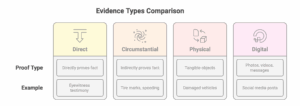So, you’ve been injured in an accident and are considering a personal injury claim? One of the most important factors determining the success of your case is the evidence you can gather and present. Think of it like building a strong foundation – solid evidence supports your claim and significantly increases your chances of a fair settlement. This guide walks you through everything you need to know.
Understanding Evidence in Your Personal Injury Case
In legal terms, evidence is anything presented to a court to prove or disprove facts. In a personal injury case, the goal is to demonstrate that someone else’s negligence caused your injuries and resulting damages (medical bills, lost wages, pain and suffering, etc.). To prove negligence, you need to show:
- Duty of care: The responsible party had a legal obligation to act reasonably to prevent harm.
- Breach of duty: They failed to meet that obligation.
- Causation: Their failure directly caused your injuries.
- Damages: You suffered actual losses because of those injuries.
Think of it as a puzzle. Evidence provides the pieces needed to form a clear picture for the insurance company or a jury.
Gathering the Right Evidence: A Comprehensive Checklist for Your Personal Injury Claim
What evidence should you collect? Here’s a comprehensive checklist:
- Medical Records: Document all treatments, diagnoses, and prognoses related to your injuries. Keep track of every doctor’s visit, physical therapy session, and medication.
- Police Reports: If the accident was reported to the police (especially crucial in car accidents), obtain a copy of the official report. This usually contains crucial details like witness statements and the officer’s assessment of the scene.
- Photos and Videos: Visual documentation is powerful. Photograph the accident scene, vehicle damage, your injuries, and anything else relevant. Take videos if possible.
- Witness Statements: Get contact information from anyone who witnessed the accident. Their accounts can be invaluable.
- Lost Wage Documentation: Gather pay stubs, tax returns, and letters from your employer to demonstrate lost income.
- Bills and Receipts: Keep track of all expenses related to your injuries, including medical bills, prescriptions, transportation costs, and assistive devices.
- Personal Journal: Document your pain levels, limitations, and how the injuries are affecting your daily life. This helps illustrate the impact on your well-being.
- Employment Records: Provide evidence of lost wages
- Vehicle Information: Include VIN, license plate, and registration
Types of Evidence That Can Win Your Personal Injury Case
Here’s a breakdown of evidence types:

- Direct Evidence: Directly proves a fact. An eyewitness testifying that they saw the defendant run a red light is direct evidence.
- Circumstantial Evidence: Indirectly proves a fact, requiring the jury to make an inference. For example, tire marks at an accident scene, along with testimony about the defendant speeding, are circumstantial evidence that they caused the accident.
- Physical Evidence: Tangible objects related to the incident, like damaged vehicles, clothing, or equipment.
- Digital Evidence: This includes photos, videos, emails, text messages, and social media posts. Be careful what you post online after an accident, as it can be used against you.
Preserving Evidence: Protecting Your Personal Injury Claim from Day One
Evidence can disappear or be altered if not properly preserved. Here’s what you need to do:
- Take Photos Immediately: Document the scene before anything is moved or altered.
- Keep Everything: Don’t discard anything related to the accident, even if it seems insignificant.
- Store Evidence Securely: Keep documents and physical evidence organised and protected from damage.
- Digital Evidence: Backup photos, videos, and other digital data in multiple locations.
- Spoliation: Know that destroying or altering evidence can seriously harm your case. If you are in possession of evidence, do not get rid of it.
Real-Life Winning Examples: How Solid Evidence Secured Favourable Personal Injury Settlements
Let’s look at real examples:
- Car Accident (Distracted Driving): A plaintiff secured a $500,000 settlement after a car accident. Strong evidence included: the police report citing the defendant for texting while driving, cell phone records confirming text messages were sent at the time of the accident, and witness testimony corroborating the plaintiff’s account.
- Slip and Fall (Negligent Maintenance): A woman won $75,000 after slipping on a wet floor in a grocery store. Crucial evidence included: security camera footage showing the spill wasn’t cleaned up for over an hour, store incident reports documenting previous slip-and-fall accidents in the same area, and medical records detailing the woman’s injuries.
Common Mistakes to Avoid When Collecting Evidence for Your Personal Injury Case
- Waiting Too Long: Memories fade and evidence can be lost or altered over time.
- Not Documenting Everything: Even seemingly minor details can be important.
- Tampering with Evidence: Never alter or fabricate evidence; this can lead to serious legal consequences.

- Talking Too Much: Avoid discussing the accident with anyone other than your attorney. Be especially cautious about social media.
- Failing to Seek Medical Attention: Delaying medical treatment can weaken your claim by suggesting your injuries weren’t serious.
Expert Evidence: When You Need Professional Help to Strengthen Your Personal Injury Case
In complex personal injury cases, expert witnesses can be invaluable. These professionals can provide specialised knowledge and opinions to support your claim.
- Accident Reconstruction Experts: Analyse accident scenes to determine the cause of the accident and liability.
- Medical Experts: Review medical records and testify about the nature and extent of your injuries, as well as future medical needs.
- Economic Experts: Calculate lost wages, future earning capacity, and other economic damages.
Navigating the complexities of evidence collection and presentation can be challenging. Consulting with an experienced personal injury attorney is crucial to protect your rights and maximise your chances of a successful outcome. An attorney understands the rules of evidence, can help you gather the necessary documentation, and will present your case in the most compelling way possible.
This article provides general information and is not legal advice. You should consult with an attorney for advice regarding your specific situation.


